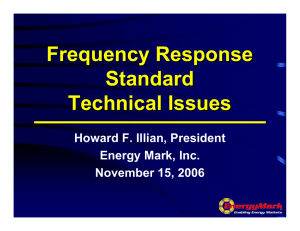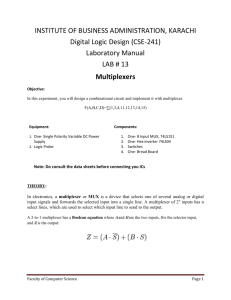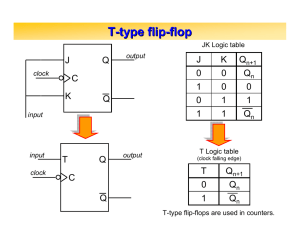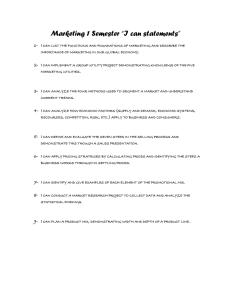AN-1024 APPLICATION NOTE
advertisement
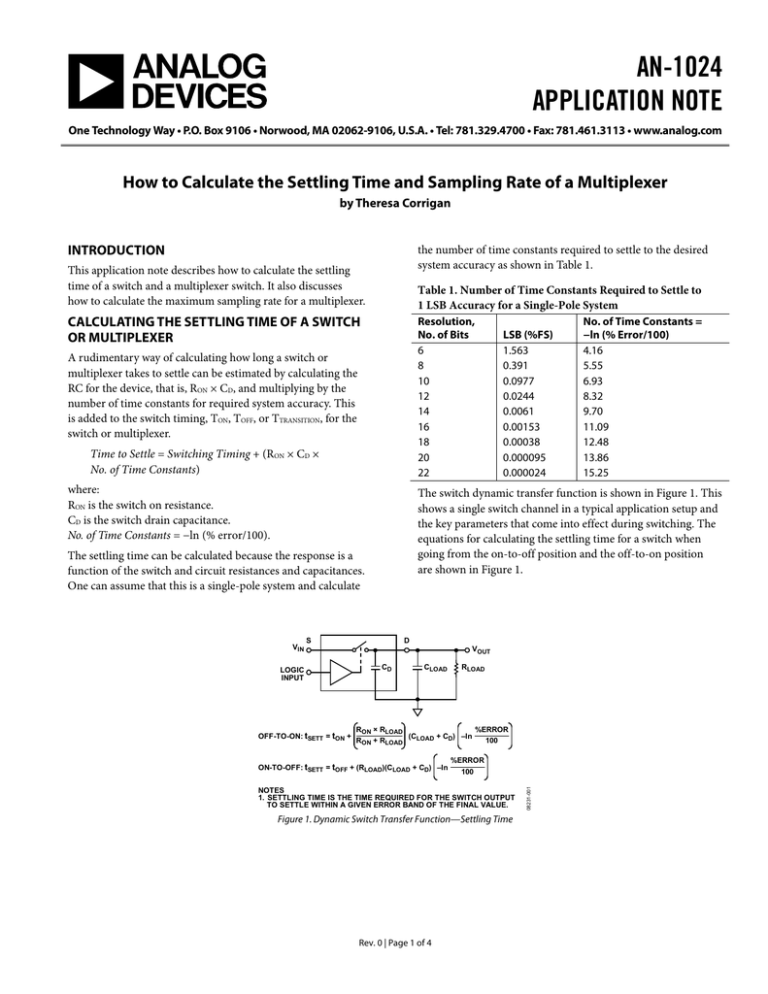
AN-1024 APPLICATION NOTE One Technology Way • P.O. Box 9106 • Norwood, MA 02062-9106, U.S.A. • Tel: 781.329.4700 • Fax: 781.461.3113 • www.analog.com How to Calculate the Settling Time and Sampling Rate of a Multiplexer by Theresa Corrigan the number of time constants required to settle to the desired system accuracy as shown in Table 1. INTRODUCTION This application note describes how to calculate the settling time of a switch and a multiplexer switch. It also discusses how to calculate the maximum sampling rate for a multiplexer. Table 1. Number of Time Constants Required to Settle to 1 LSB Accuracy for a Single-Pole System CALCULATING THE SETTLING TIME OF A SWITCH OR MULTIPLEXER Resolution, No. of Bits 6 8 10 12 14 16 18 20 22 A rudimentary way of calculating how long a switch or multiplexer takes to settle can be estimated by calculating the RC for the device, that is, RON × CD, and multiplying by the number of time constants for required system accuracy. This is added to the switch timing, TON, TOFF, or TTRANSITION, for the switch or multiplexer. Time to Settle = Switching Timing + (RON × CD × No. of Time Constants) where: RON is the switch on resistance. CD is the switch drain capacitance. No. of Time Constants = −ln (% error/100). S OFF-TO-ON: tSETT = tON + D VOUT CD RON × RLOAD RON + RLOAD CLOAD RLOAD (CLOAD + CD) –ln ON-TO-OFF: tSETT = tOFF + (RLOAD)(CLOAD + CD) –ln %ERROR 100 %ERROR 100 NOTES 1. SETTLING TIME IS THE TIME REQUIRED FOR THE SWITCH OUTPUT TO SETTLE WITHIN A GIVEN ERROR BAND OF THE FINAL VALUE. Figure 1. Dynamic Switch Transfer Function—Settling Time Rev. 0 | Page 1 of 4 08231-001 LOGIC INPUT No. of Time Constants = −ln (% Error/100) 4.16 5.55 6.93 8.32 9.70 11.09 12.48 13.86 15.25 The switch dynamic transfer function is shown in Figure 1. This shows a single switch channel in a typical application setup and the key parameters that come into effect during switching. The equations for calculating the settling time for a switch when going from the on-to-off position and the off-to-on position are shown in Figure 1. The settling time can be calculated because the response is a function of the switch and circuit resistances and capacitances. One can assume that this is a single-pole system and calculate VIN LSB (%FS) 1.563 0.391 0.0977 0.0244 0.0061 0.00153 0.00038 0.000095 0.000024 AN-1024 Application Note TSETTLE MUX = 80 ns + 8.2 ns The settling time of a multiplexer is calculated in the same way as that of a switch, except that the multiplexer transition time is used instead of TON/TOFF as in the case of a switch (see Formula A). TSETTLE MUX = 88 ns CALCULATING THE MAXIMUM SAMPLING RATE FOR A MULTIPLEXER Formula A Formula B is used to calculate the maximum sampling rate of a multiplexer, fS. TSETTLE MUX = TTRANSITION + [(RON × RLOAD/RON + RLOAD) × (CLOAD + CD) × (No. of Time Constants)] Formula B The settling time of the ADG1208 to 10-bit accuracy for a typical application setup is now calculated using Formula A. fS = 1/[(TSETTLE MUX) (No. of channels)] where TSETTLE MUX is calculated using Formula A. TSETTLE MUX = TTRANSITION + [(RON × RLOAD/RON + RLOAD) × (CLOAD + CD) × (No. of Time Constants)] Thus, for the ADG1208, where Thus, using the typical data sheet specification at ±15 V supply TSETTLE MUX = 88 ns RON = 120 Ω No. of Channels = 8 CD (OFF) = 6 pF this gives a maximum sampling rate of And application parameters of fS = 1/[(88 ns) (8)] = 1.4 MSPS RLOAD = 1 kΩ CLOAD = 5 pF TSETTLE MUX = TTRANSITION + [(RON × RLOAD/RON + RLOAD) × (CLOAD + CD) × (No. of Time Constants)] A switch/multiplexer settling time calculator is available on the Analog Devices, Inc. website. 08231-002 TSETTLE MUX = 80 ns + [(120 × 1000/120 + 1000) × (5 pF + 6 pF) × (6.93)] CALCULATING THE SETTLING TIME OF A SWITCH OR MULTIPLEXER USING THE ONLINE SETTLING TIME CALCULATOR Figure 2. Switch/Multiplexer Calculator Tool Rev. 0 | Page 2 of 4 Application Note AN-1024 This calculator estimates the settling time for a multiplexer by calculating the slower of the two time constants for a cascaded RC network, and then computing how many of that time constant must pass before the system settles to within 1%, 0.1%, 0.01%, and 0.001% of its final value. As mentioned, the calculator does not include the switch timing (TON, TOFF, or TTRANSITION) in the settling time calculation, it just calculates based on the RC for the system times the number of time constants. Accounting for the switch timing gives very similar results as those given by Formula A. Note that the online settling tool calculates settling time as RC × the number of time constants. It does not include the switching timing (TON, TOFF, or TTRANSITION). CALCULATING MAXIMUM SAMPLING RATE FOR A MULTIPLEXER USING THE ONLINE CALCULATOR The online settling calculator also estimates the maximum sampling rate possible for a classic ADC with S/H input. The sampling rate is estimated as 1/sqrt. To use the calculator, enter the multiplexer parameters in RON (switch or multiplexer on resistance), CS(OFF) (source off capacitance), and CD(OFF) (drain off capacitance). [(TSETTLE+TTRANSITION)2 + tPGA2] Enter the application parameters in RSOURCE, RLOAD and CLOAD. Tab from one field to the other to update the tabular display or click Calculate. As an example, the online tool can be used to calculate the settling time of the ADG1208 multiplexer. Again, the typical data sheet specification at ±15 V supply is used for this example. RON = 120 Ω CS (OFF) = 1.5 pF CD (OFF) = 6 pF With application parameters of RSOURCE = 0 Ω RLOAD = 1 kΩ CLOAD = 5 pF This online tool gives the maximum sampling rate for a single multiplexer channel. If you require the maximum sampling rate for all channels on the multiplexer being switched, then divide the sample rate given by the calculator by the number of channels being switched. As shown in Figure 3, the calculator gives a maximum sampling rate for the ADG1208 of 11.24 MSPS. This is based on switching just one channel. If all eight channels of the ADG1208 need to be switched, then this number should be divided by 8; 11.24MSP/8 = 1.4 MSPS sampling rate for eight channels of the ADG1208, settling to 10 bits. Again, this gives the same result as when using Formula B. 08231-003 This gives a settling time of 9 ns if settling to 10-bits of accuracy, as shown in Figure 3. This number should be less than the sum of tACQ + tCONV for the ADC; otherwise, the maximum sampling frequency is limited by the latter. The maximum sampling frequency estimate is shown in megasamples/sec to the right of the settling time number, as shown in Figure 3. Figure 3. Settling Time Calculator Showing the ADG1208 as an Example Rev. 0 | Page 3 of 4 AN-1024 Application Note NOTES ©2009 Analog Devices, Inc. All rights reserved. Trademarks and registered trademarks are the property of their respective owners. AN08231-0-7/09(0) Rev. 0 | Page 4 of 4
